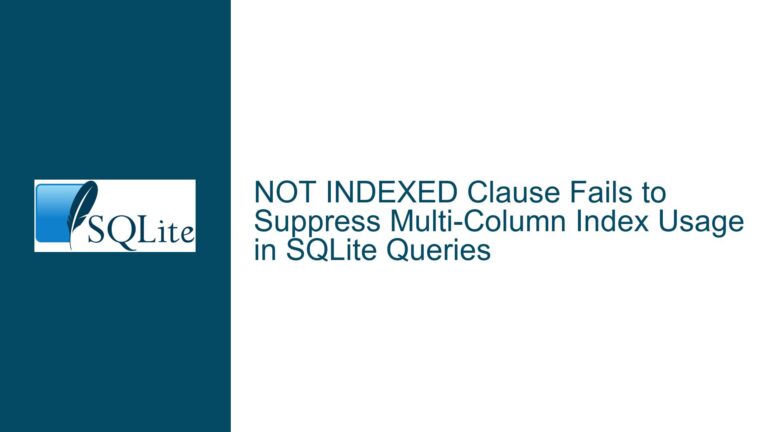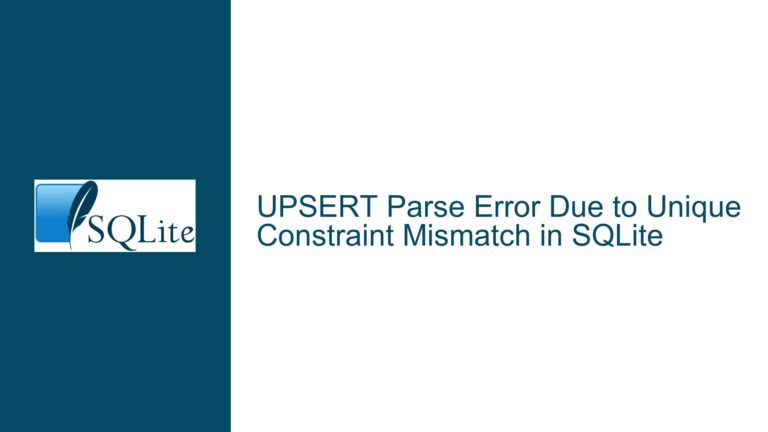Unexpected Parse Error in SQLite: HAVING Clause Without GROUP BY
Issue Overview: HAVING Clause Misinterpretation in Aggregate Queries
The core issue revolves around a parse error in SQLite that occurs when a query involving an aggregate function is executed without an explicit GROUP BY clause, but the error message references a HAVING clause that is not present in the original SQL statement. This behavior is particularly confusing because the query does not explicitly include a HAVING clause, yet the error message suggests that one is required. The problem manifests in specific versions of SQLite, particularly in versions 3.35.0 and later, due to an optimization introduced in these versions.
The query in question involves the creation of a view (v0) that uses the RANK() window function and the SUM() aggregate function. When this view is queried with a WHERE clause, SQLite attempts to optimize the query by pushing the WHERE clause down into the subquery. However, because the subquery contains an aggregate function (SUM(0)), SQLite converts the WHERE clause into a HAVING clause internally. This conversion is necessary to maintain the semantic meaning of the query, as HAVING clauses are used to filter results after aggregation, whereas WHERE clauses filter rows before aggregation.
The error arises because SQLite historically enforces a rule that a HAVING clause must be accompanied by a GROUP BY clause. This rule is not universally enforced in other databases like PostgreSQL, which allows HAVING clauses to be used with aggregate queries without requiring a GROUP BY clause. The discrepancy between SQLite’s behavior and that of other databases can lead to confusion, especially for developers who are accustomed to the more permissive behavior of PostgreSQL.
Possible Causes: Query Optimization and Semantic Rules
The root cause of this issue lies in the interplay between SQLite’s query optimization strategies and its semantic rules for aggregate queries. Specifically, the problem can be traced back to two key factors: the push-down optimization introduced in SQLite 3.35.0 and the historical requirement for a GROUP BY clause when using a HAVING clause.
Push-Down Optimization: In SQLite 3.35.0, a new optimization was introduced that allows the query planner to push WHERE clauses from an outer query into a subquery or view. This optimization is designed to improve query performance by allowing the query planner to apply filtering conditions earlier in the query execution process. However, when the subquery or view contains an aggregate function, the WHERE clause must be converted into a HAVING clause to preserve the correct semantics. This conversion is necessary because WHERE clauses filter rows before aggregation, while HAVING clauses filter rows after aggregation.
GROUP BY Requirement: SQLite has historically required that any query containing a HAVING clause must also include a GROUP BY clause. This requirement is based on the idea that HAVING clauses are used to filter groups of rows, and therefore, the query must explicitly define how the rows are grouped. However, this requirement is not strictly necessary from a logical standpoint, as demonstrated by PostgreSQL, which allows HAVING clauses to be used with aggregate queries without requiring a GROUP BY clause. The enforcement of this rule in SQLite can lead to unexpected errors, particularly when the HAVING clause is introduced internally by the query optimizer.
The combination of these two factors—the push-down optimization and the GROUP BY requirement—creates a situation where a query that appears to be valid can result in a parse error due to an internally generated HAVING clause. This issue is further complicated by the fact that the behavior varies between different versions of SQLite, with some versions allowing the query to execute without error and others enforcing the GROUP BY requirement.
Troubleshooting Steps, Solutions & Fixes: Addressing the Parse Error
To resolve the parse error and ensure that your queries execute correctly across different versions of SQLite, you can take several approaches. These include modifying your queries to explicitly include a GROUP BY clause, using alternative query structures, or upgrading to a version of SQLite that has addressed this issue.
1. Explicitly Include a GROUP BY Clause: The most straightforward solution is to modify your query to include a GROUP BY clause, even if it is not strictly necessary from a logical standpoint. This approach ensures that the query adheres to SQLite’s historical requirement for a GROUP BY clause when using a HAVING clause. For example, you can modify the original query as follows:
CREATE VIEW v0(c0, c1) AS SELECT RANK() OVER (PARTITION BY 0), SUM(0) GROUP BY 1;
SELECT * FROM v0 WHERE 1;
In this modified query, the GROUP BY 1 clause explicitly groups the results by the first column (c0), which satisfies SQLite’s requirement for a GROUP BY clause when using a HAVING clause. This modification ensures that the query will execute without error, even in versions of SQLite that enforce the GROUP BY requirement.
2. Use Alternative Query Structures: If modifying the query to include a GROUP BY clause is not feasible, you can consider using alternative query structures that achieve the same result without triggering the parse error. For example, you can rewrite the query to avoid the use of aggregate functions in the view, or you can use a Common Table Expression (CTE) to separate the aggregation from the filtering. Here is an example of how you can rewrite the query using a CTE:
WITH aggregated_data AS (
SELECT RANK() OVER (PARTITION BY 0) AS c0, SUM(0) AS c1
)
SELECT * FROM aggregated_data WHERE 1;
In this rewritten query, the aggregation is performed in the CTE (aggregated_data), and the filtering is applied in the outer query. This approach avoids the need for a HAVING clause and ensures that the query will execute without error.
3. Upgrade to a Compatible Version of SQLite: If you are using a version of SQLite that enforces the GROUP BY requirement and you are unable to modify your queries, you can consider upgrading to a version of SQLite that has addressed this issue. As mentioned in the discussion, the issue was resolved in a later version of SQLite (check-in 9322a7c21f1c22ba), which allows HAVING clauses to be used with aggregate queries without requiring a GROUP BY clause. Upgrading to this version or later will ensure that your queries execute without error.
4. Understand the Impact of Query Optimization: Finally, it is important to understand the impact of SQLite’s query optimization strategies on your queries. The push-down optimization introduced in SQLite 3.35.0 can lead to unexpected behavior, particularly when dealing with aggregate queries. By understanding how this optimization works and how it can affect your queries, you can take steps to ensure that your queries are written in a way that is compatible with SQLite’s optimization strategies.
In conclusion, the parse error related to the HAVING clause in SQLite is a result of the interplay between query optimization and semantic rules. By modifying your queries to explicitly include a GROUP BY clause, using alternative query structures, upgrading to a compatible version of SQLite, and understanding the impact of query optimization, you can resolve this issue and ensure that your queries execute correctly across different versions of SQLite.






